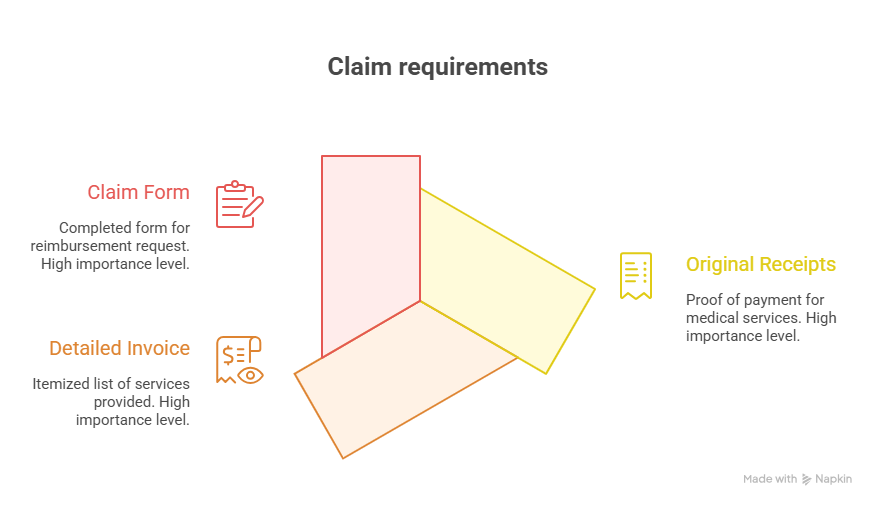Although it can be difficult to navigate, filing medical claims is an essential part of controlling your healthcare expenses. Millions of Americans frequently face unforeseen financial burdens as a result of their inability to comprehend the process of filing for medical expense reimbursement.
This burden can be considerably reduced with a thorough understanding of the claim procedure. With the help of our in-depth guide, which includes sample templates to make sure you’re ready, you can follow the steps required for a successful claim.
You can effectively submit your medical expense claims and guarantee that you get the reimbursement you are due by using this guide. Together, let’s streamline the procedure.
Understanding the Doctor Visit Reimbursement Request Process
When properly completed, a number of crucial steps in the doctor visit reimbursement request process can result in the submission of a successful medical claim. It’s essential to comprehend the requirements and deadlines in order to successfully navigate this process.
When to Submit a Reimbursement Request
Timely submission of a reimbursement request is crucial. The majority of insurance companies have a deadline for filing claims. This usually occurs between 30 and 90 days following the doctor’s appointment. To make sure you don’t miss the window for reimbursement, check your insurance policy for the precise deadline.
Required Documentation for Medical Expense Reimbursement
A few documents must be submitted in order to process a physician visit reimbursement. These usually consist of an accurately completed claim form, a thorough invoice from the healthcare provider, and the original receipts for medical expenses. A successful reimbursement depends on all documentation being accurate and complete.
| Document Type | Description | Importance Level |
|---|---|---|
| Original Receipts | Proof of payment for medical services | High |
| Detailed Invoice | Itemized list of services provided | High |
| Claim Form | Completed form for reimbursement request | High |

Common Reasons for Claim Denials
Incomplete documentation, missed deadlines, or inaccurate information on the claim form are just a few of the reasons why claims may be rejected. It can be easier to prepare a successful healthcare claim submission if you are aware of these typical pitfalls. It is essential to make sure that all information is correct and submitted on schedule.
Step-by-Step Guide to Submitting Your Doctor Visit Reimbursement
Processing time can be greatly decreased by submitting a doctor visit reimbursement claim in an organized manner. Understanding the steps involved in submitting a reimbursement request is essential to ensuring a seamless process.
Compiling Your Medical Documents and Bills
Getting all required medical records and receipts is the first step in submitting a reimbursement request form. This comprises hospital bills, doctor’s notes, and any other pertinent records pertaining to your visit.
Make sure every receipt is thorough and contains the date of service, the healthcare provider’s name, and an explanation of the services provided.
Examples of Reimbursement Request Templates
The procedure can be made simpler by using a reimbursement request form template. Employer-specific forms and general insurance claim templates are among the many templates that are available.
Template for General Insurance Claims
Your personal information, insurance details, and a description of the medical services you received are usually included in a general insurance claim template. You can modify this template to work with different insurance companies.
Forms for Employer-Specific Reimbursement
Certain employers offer their own reimbursement forms, which might call for extra details unique to your business’s regulations. Be sure to complete these forms completely and accurately.
Monitoring the Submission of Your Healthcare Claim
It’s critical to monitor the status of your insurance reimbursement for doctor visit claim after you’ve submitted it. Make a note of everything you submit, including the date and any follow-ups.
You can guarantee a successful and effective reimbursement process by adhering to these guidelines and making use of the appropriate templates.
Making Your Medical Visit Reimbursement Process Easier
With the correct information, filing a claim for reimbursement for a doctor’s visit can be simple. You can successfully submit a claim for medical expenses if you comprehend the requirements and adhere to the instructions provided in this guide.
The process of filing an insurance claim for medical costs can be complicated, but it can be easily handled if you have the proper paperwork and a thorough understanding of your insurance policy. Don’t forget to collect all the paperwork you’ll need to back up your claim, such as receipts and medical records.
You can guarantee a seamless and effective claims procedure by carefully reading your insurance policy and submitting a thorough reimbursement request. To begin the process of getting your medical costs reimbursed, begin filing your doctor visit reimbursement claim right now.
FAQ
How long does it usually take to submit a request for reimbursement for a doctor’s visit?
Depending on the insurance company or employer, there are different deadlines for submitting a doctor visit reimbursement request. It is generally advised that you file your claim between 30 and 90 days following the date of the doctor’s appointment.
What paperwork is needed to get reimbursed for medical expenses?
Medical records, payment receipts, and a filled-out reimbursement request form are usually required in order to process your medical expense reimbursement. Verify that every document is correct and readable.
How can I monitor the status of my submitted medical claim?
By getting in touch with your insurance company or employer’s human resources department directly, you can monitor the status of your healthcare claim submission. Additionally, a lot of insurance companies have online portals that you can access to see how your claim is progressing.
How can I prevent claim denials, and what are the typical causes?
Inaccurate or partial information, missing supporting documentation, and past-due submission deadlines are common grounds for claim denials. Verify your application again, make sure all necessary documents are included, and submit your claim on time to prevent these problems.
Can I submit my reimbursement request using a general insurance claim template?
Yes, you can begin your reimbursement request by using a general insurance claim template. But make sure to ask your employer or insurance company if there are any particular forms or requirements that must be followed.
After I file my claim, how long does it take to get paid back?
Reimbursement claim processing times can differ. The average turnaround time for reimbursement is a few days to a few weeks. If you haven’t heard back from your employer or insurance company in a fair amount of time, don’t hesitate to follow up.




